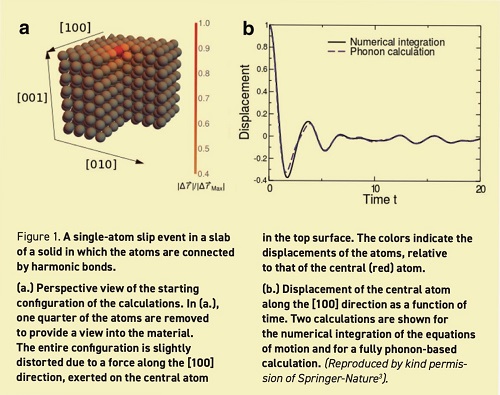Separating Fact from Friction
Drs. Wilfred T. Tysoe & Nicholas D. Spencer | TLT Cutting Edge April 2020
The way in which frictional dissipation initially occurs may have a relatively simple explanation.
It is generally believed that friction arises from the coupling of a slip event to the lattice vibrations (phonons) in sliding solid bodies, which end up, somehow, being converted into heat, where the energy is fully distributed over the phonon spectrum (that is, all the collective lattice vibrations). The process is initiated by the atoms involved in the local sliding contact being displaced by static friction, and the displaced atoms then being released in the slip event.
The displaced atoms do not oscillate forever, but rather they are rapidly damped (with a characteristic time approximately equal to their vibrational period called critical damping) by processes related to finite phonon lifetimes, and thus the energy is dissipated. J.B. Sokoloff summarized this well when he proposed that friction should be considered as “the conversion of organized translational energy into random vibrational energy which cannot be recovered because of its random nature.”1 This partially explains the distinct stick-slip events that we see in high-resolution lateral force microscopy images and it is assumed in the dissipation step in the Prandtl-Tomlinson model for friction.
In real systems, many factors can contribute to this road to dissipation, including the anharmonicity of the bonds between the atoms in the solid, as well as interactions of phonons with defects in the lattice. However, it turns out that the initial step in this process may be much simpler and much faster—defects and bond anharmonicity may not be necessary at all, and are anyway probably too slow to result in critical damping. Initial hints in this direction were already evident from the work of Adelman and Doll in the 1970s,2 who were working on scattering of gas molecules off solid surfaces or Sokoloff in the early 1990s,1 who explored the possibility of small arrangements of atoms leading to zero friction.
Professor Joost Frenken and his colleagues Renfeng Hu and Sergey Krylov at the Advanced Research Center for Nanolithography in Amsterdam recently published a paper in Tribology Letters3 showing that a model solid, containing only harmonic (i.e., lossless) bonds between the atoms, with no defects, can rapidly dissipate frictional energy, effectively leading to critical damping. They named this harmonic material Harmonium (Chemical symbol Hr!).

Imagine laterally tweaking an atom on the surface of a solid block of harmonium, as shown in Figure 1. The oscillations this induces as it returns to its starting position are shown to be damped within very few cycles, simply due to the fact that, by means of their (purely harmonic) coupling to all the other atoms (the diffusing red shade), they induce oscillations in all other atoms in the block. The lattice vibrations (phonons) comprise collective vibrations of the entire lattice and have a range of different wavelengths. This means that the initial local displacement (corresponding to the initial tweak) requires the combination of many phonons with different wavelengths to constructively interfere at one point. As a result, when the tweaked atom is released, many phonons of different frequencies are excited throughout the lattice, the phonon waves being initially aligned (that is, they are said to be in phase), corresponding to the localized disturbance by the tweaked atom.
The phonons then rapidly move out of phase with each other, destructively interfering as they effectively dissipate the tweak throughout the phonon spectrum (i.e., producing heat). This is beautifully illustrated in the authors’ movie of a molecular-dynamics simulation of the process, which can be accessed via their article,3 where the initial tweak can be visualized as being distributed throughout the entire lattice.
While such phenomena are familiar to the solid-state physics community in other contexts (in fact the article has already tweaked others to initiate some discussion).4,5 Frenken et al., have done us a service by alerting tribologists to their relevance to friction. In an interdisciplinary field such as ours, established effects in other fields need to be disseminated in this way. We benefit from being constantly educated by one another in order to move our field forwards (with as little dissipation as possible).
FOR FURTHER READING
1. Sokoloff, J.B. (1993), “Fundamental mechanisms for energy dissipation at small solid sliding surfaces,” Wear, 167, pp. 59-68.
2. Adelman, S.A., Doll, J.D. (1976), “Generalized Langevin equation approach for atom/solid‐surface scattering: General formulation for classical scattering off harmonic solids,” J. Chem. Phys., 64, 2375.
3. Hu, R., Krylov, S.Y., Frenken, J. W. M. (2019), “On the Origin of Frictional Energy Dissipation,” Tribology Letters, 68 (8), click here.
4. Persson, B. N. J. (2020), Comment on “On the Origin of Frictional Energy Dissipation,” Tribology Letters, 68 (28), click here.
5. Frenken, J. W. M. (2020), Reply to Comment on “On the Origin of Frictional Energy Dissipation,” Tribology Letters, 68 (35), click here.
Eddy Tysoe is a distinguished professor of physical chemistry at the University of Wisconsin-Milwaukee. You can reach him at wtt@uwm.edu.
Nic Spencer is professor of surface science and technology at the ETH Zurich, Switzerland, and editor-in-chief of STLE-affiliated Tribology Letters journal. You can reach him at nspencer@ethz.ch.